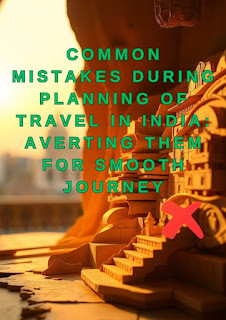Common Mistakes during Planning of Travel in India Averting Them for Smooth Journey
It's simply nothing but magic while traveling in India, with the differences it boasts of, in terms of culture, history, and landscapes. However, it is pretty tough to plan a trip here if done wrong. Avoiding the mistakes that are commonly made during planning might enhance your journey and help you enjoy all that India has to offer. Here's how the top mistakes travelers make while planning can be avoided, as described in this article.
Table of Contents
1 Overlooking Seasonal Variations
2. Neglecting Research on Local Culture
3. Ignoring Health and Safety Precautions
4. Underestimating Travel Distances
5. Overpacking for the Journey
6. Not Planning Accommodation in Advance
7. Skipping Travel Insurance
8. Overloading the Itinerary
9. Relying Solely on Digital Maps
10. FAQs
1. Overlooking Seasonal Variations
India has different climates, ranging from scorching summers to freezing winters. One of the common mistakes in travel planning in India is not considering the season of your visit. For example:
North India: Visit Hill stations like Himachal Pradesh and Uttarakhand during summer. Monsoons should be avoided in this region since there will be landslides in that place.
South India: Explore destinations within Kerala and Tamil Nadu between December and February to witness winter. The summer months are really hot and humid in this season. .
Rajasthan Desert Places: One must visit the place during the winters when the heat is less and not too heavy.
Tip: Research about the season and pack appropriately. One should avoid visiting hill stations during peak monsoons.
2. No research about local culture
India is vast and varied in the states, languages, customs, and food. Most tourists forget to learn about local customs and end up in embarrassing situations.
Example: In Rajasthan, one must remove his shoes before entering temples or certain homes.
Language: While the locals communicate in English and Hindi, having a little knowledge of the local language is useful.
Tip: Learn a little about the cultural habits at your destination to avoid unintentional offense.
3. Health and Safety Precautions
Health and safety are of paramount importance when visiting India. The most common mistakes include:
Failure to Vaccinate: Hepatitis A, Typhoid, and Malaria vaccinations are recommended.
Tap Water: Always drink bottled or filtered water.
Street Food Hygiene: However tempting it may seem, ensure food is fresh and hot.
Tip: Carry basic medicines and a first-aid kit. Do not buy from roadside stalls unless very crowded and reputed.
4. Traveling Underestimation of distances
India is huge. Distances appear deceptively short on maps.
Illustration: Road journey Delhi to Jaipur will actually take 5-6 hours without taking into consideration the traffic jam.
Traveling modes: For extensive distances, one may look at traveling by train and flight which can be a quicker mode.
Tip: Be realistic in planning your travel schedule, accounting for rest and delays in travel.
5. Overpacking for the Journey
Many travelers make the mistake of overpacking, which is a hassle.
What Not to Pack: Unnecessary clothing, large electronics, or too many valuables.
What to Pack: Comfortable clothing, sturdy footwear, a power bank, and travel-friendly toiletries.
Tip: Plan according to the climate and activities at your destination to pack smartly.
6. Unadvanced Accommodation Arrangements
India's tourism industry is booming, and accommodation varies from five-star hotels to budget hostels. However, when booking at the last minute, it may result in:
Hiked prices
Few choices, especially in the peak seasons or festivals
Book your stays ahead of time through reliable websites. Look for reviews and choose places near your intended activities.
7. Failure to Purchase Travel Insurance
Travel insurance is one of the most overlooked, but the need for it is necessary. It comes in handy with unforeseen events such as:
Travel cancellations
Medical emergencies
Lost baggage
Tip: Look for wide travel insurance coverage, especially for adventure activities.
8. Overcrowding the Itinerary
India's rich heritage tends to lure travelers into trying to do too much in one go.
Result: Fatigue and being unable to absorb fully what each destination has to offer.
For example, trying to cover Delhi, Agra, and Jaipur in two days can be exhausting.
Quality over quantity. Plan enough time for rest and exploration.
9. Digital Maps Alone
Google Maps is a godsend, but not always reliable in India, especially in the rural or hill stations.
Example: In the remote village or mountains, maps could mislead or show roads that do not exist.
Carry a physical map, or ask locals for directions.
Tip: Download the offline maps and consult with locals when unsure.
FAQs
Q1. Which are the best months to visit India?
A: October to March is ideal for most regions, avoiding extreme weather.
Q2. Is it safe to travel alone in India?
A: Yes, but take precautions like avoiding isolated areas at night and using trusted transportation.
Q3. What should not I eat in India?
A: Avoid raw foods, tap water, and unhygienic street food. Instead opt for fresh hot foods
Q4. Is there any cultural do's and don'ts in India?
A: Respect local culture. Moderation is key; do not kiss or demonstrate public intimacy in the villages.
Q5. Do I require a visa to visit India?
A: A visa is necessary for all but the citizens of a few countries. You could easily access the government's e-visa website.
End
Travelling in India can be a highly rewarding experience if planned well. The avoidance of these common travel planning mistakes in India will ensure you have a hassle-free, memorable journey. Be it the majestic Himalayas, serene backwaters of Kerala, or historic forts of Rajasthan, proper preparation is the key to a successful adventure. Happy travels!




0 Comments